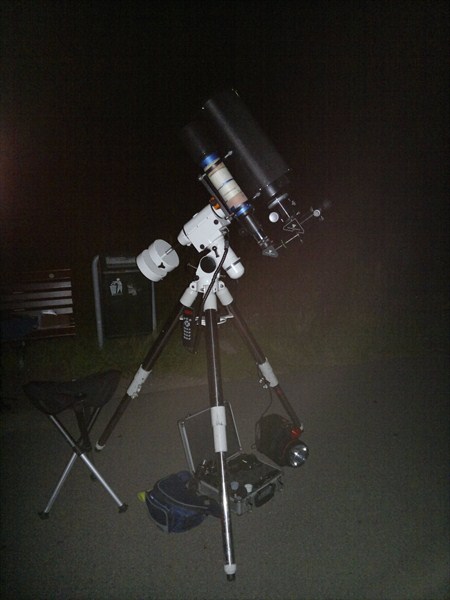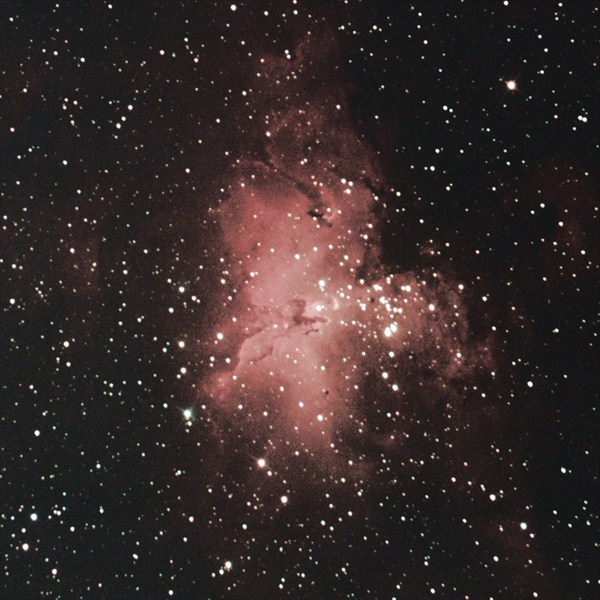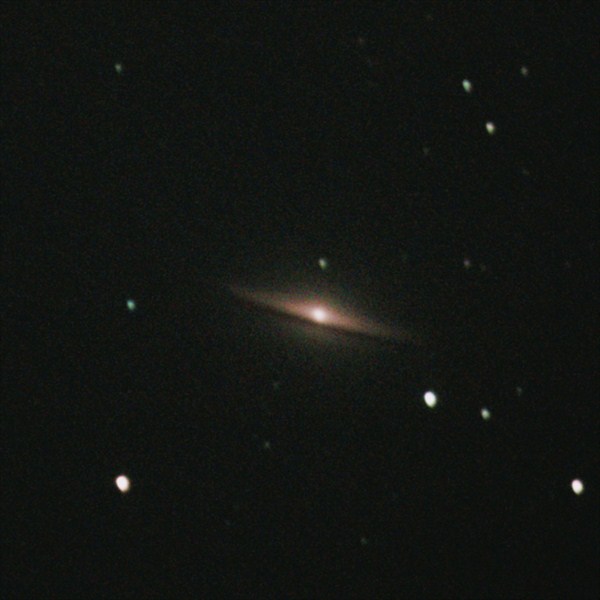Deutsch | Intro | 1. Beobachtungsort | 2. Beobachtungsort | 3. Beobachtungsort
English | Intro | 1st Observation Location | 2nd Observation Location | 3rd Observation Location
Intro

Hobby- und Berufsastronomen suchen sich für ihre Arbeit Orte, an denen sehr gute Beobachtungsbedingungen herrschen. Große Höhe zum Beispiel wegen der dünnen Luft. Oder irgendwo im Nirgendwo, wo es wenig Lichtverschmutzung (künstliches Licht) gibt. Wer in Berlin wohnt, hat es da schwer.
Ich habe für mein Hobby drei Positionen gefunden, die alle unterschiedliche Vorzüge und Nachteile haben. Der Cache wird Dich dorthin führen. Sie sind Stationen dieses Mysterys. In klaren, mondlosen Nächten kann man mich vielleicht sogar dort antreffen. Ein wenig astronomisches Wissen wird von Nutzen sein. Je mehr man davon hat oder je mehr man recherchiert umso einfacher wird es werden. Schul bzw. Allgemeinwissen ist eine gute Ausgangsbasis.
Idealerweise gehst Du die Sache in der Nacht an. Dann erlebst Du die Locations zu Zeiten wo sie ihren Zweck erfüllen. Wer das nicht kann oder möchte oder die Wildschweine fürchtet, kann auch ein wenig mehr Know-how reinstecken und kommt mit Tagesbesuchen vor Ort aus.
1. Beobachtungsort

Die Koordinaten des ersten Beobachtungsortes sind öffentlich (waypoint N1, 1STOL, 1st Observing Location). Diesen benutze ich, wenn die anderen beiden, an die Dich der Cache noch führen wird, nicht verfügbar sind. Hier gibt es zwar Stadtlichter, aber für Beobachtungen höher als 40° am Himmel geht es. Das nebenstehende Foto des Kugelsternhaufens Messier 15 "Cúmulo de Pegaso" ist hier entstanden.
Mit den Lösungen der Aufgaben (siehe unten) begibst Du Dich hier her um den Schlüssel für die Koordinaten des 2. Beobachtungsortes zu finden. Suche GRÜNDlich nach einem Container der Größe eines Petlings oder einer Filmdose. Schnee oder hohes Gras können den Schwierigkeitsgrad hier erhöhen. Wäre dies ein Traditional, würde ich ihm 2/1.5 geben.
Derzeit (Sep 2013) ist der Bewuchs hier stellenweise hoch. Es gibt eine Backup-Location, wo die Koordinaten angebracht sind, wenn man sie an der Station selbst nicht findet: ca. 100m SO, am Tor im Zaun.
Aufgaben:
- ACW: Wo kann man den der Erde am nächsten stehenden Stern gut beobachten? Nur auf der Nordhalbkugel (484), nur auf der Südhalbkugel (373), überall (262), nichts davon (151)
- B: Wieviele Galileische Monde gibt es?
- D: Wieviele Planeten gibt es in unserem Sonnensystem?
- Z: Der sogenannte Krebs-Nebel ist im Messier Katalog astronomischer Objekte enthalten. Welche Nummer hat der Nebel in diesem Katalog?
- XY: Welche Gegend ist wegen der klimatischen und meteorologischen Bedingungen ein Mekka für Hobbyastronomen? Luxemburg (64), Philippinen (75), Namibia (86), Antarktika (97)
Beim Verstauen bitte wieder ein klein wenig tarnen. Sonst wäre die Sache zu offensichtlich für Muggels.
2. Beobachtungsort


Die Koordinaten, die Du am ersten Beobachtungsort erhalten hast, liefern Dir den zweiten Beobachtungsort. Er ist etwas ruhiger und hat auch nicht ganz so viele Lichter. Deshalb ziehe ich ihn dem ersten vor. Jedoch gibt es hier immer freitags Flutlicht und dann kann er nicht genutzt werden. Die nebenstehenden Fotos des Adlernebels Messier 16 und der Sombrero-Galaxie Messier 104 sind hier entstanden.
Die weiterführende Information findest Du nicht direkt am Beobachtungsort. Hier ist es nicht muggelsicher. Stattdessen lässt Du Polaris hinter Dir und lokalisierst die Beschallungsanlage am weißen Zaun. Der Zaun wird Dir dann weiterhelfen. Containergröße Micro. Vorsicht vor Muggeln. Sie sind hier sehr aufmerksam; ich wurde beim Kontrollieren einmal für einen Drogenkurier gehalten.
Du wirst Daten für einen Leitstern finden, die Du am dritten Beobachtungsort brauchen wirst, um den Cache zu heben. Also am Besten alles abfotografieren oder abschreiben! Bitte nichts mitnehmen: alles was Du vorfindest, muß hierbleiben. Wäre dies ein Traditional, würde ich ihm 1/2 geben.
3. Beobachtungsort

Diese Station ist der dritte und letzte Beobachtungsort, der in diesem Cache angelaufen wird. Hier herrschen von allen 3 Orten die besten Bedingungen: am wenigsten neugierige Leute und am wenigsten Licht. Nur freitags ist's wieder schlecht, siehe zweiter Ort. Ein Manko stellen hier gelegentlich auch Wildschweine dar. Das nebenstehende Foto des Ringnebels Messier 57 ist hier entstanden.
Die Koordinaten dieses Beobachtungsortes sind öffentlich. Der Cache Container mit dem Logbuch befindet sich aber wiederum nicht genau an diesen Koordinaten. Aber er ist nicht allzuweit entfernt und so zu finden:
Die Zusatzinformationen vom zweiten Beobachtungsort verraten Dir einen Leitstern, also einen Stern, der Dich zum Ziel leitet. Diesen Leitstern ortest Du am Himmel und folgst ihm. Folge ihm so lange, bis Du auf ein künstliches Objekt triffst, das nicht größer ist als 10x10 Meter. Dieses Objekt beherbergt den Container des Finals. Was ist ein künstliches Objekt? Bank, Mülleimer, Zaun, asphaltierter Weg, gefällter und bearbeiteter Baumstamm, ... Keine künstlichen Objekte sind Rasen und Bäume, auch wenn durch Menschenhand angelegt.
Welcher Dein Leitstern ist, hängt natürlich vom Tag des Jahres und von der Uhrzeit ab. Deshalb enthalten die Informationen eine Liste von Tagen, Uhrzeiten und den jeweils geeigneten Leitstern. Am Besten kommst Du also an einem der angegebenen Tage zu einer der angegebenen Uhrzeiten wieder und orientierst Dich am Leitstern.
Oder Du interpolierst um das Logbuch auch an Tagen/zu Uhrzeiten finden zu können, die nicht angegeben sind. Oder Du findest einen Weg, sie sogar tagsüber zu erreichen, wenn keine Sterne sichtbar sind.
Für die ersten drei Finder liegen im Cache Container FTF, STF, TTF Zertifikate dabei. Containergröße höchstens Micro. Ganz wichtig für das langfristige Überleben des Finals: bitte wieder muggel-, wildschwein- und hundesicher verstauen, sonst gibt's ne Katastrophe.
Intro

Amateur and professional astronomers seek places where they find good observing conditions. High altitude, for example because of the thin air. Or somewhere in the middle of nowhere where there is little light pollution (ambient light). That's a tall bill when living in Berlin.
For my hobby, I found myself three locations that all have their advantages and drawbacks. This cache will lead you to those locations. They are waypoints of this mystery cache. If you are lucky you might even find me in one of them during a clear moonless night. You will find a little astronomical background knowledge helpful. The more you have or the more you research, the easier it will become. General school knowledge will be a good starting point.
It would be ideal for you to do this cache at night. That'll give you the real sense of the locations when they serve their purpose. But if you can't or don't want to or are afraid of the boar, you can just invest a little more know-how and you'll be able to finish in daylight.
1st Observation Location
 The coordinates of the first observation location are public (waypoint N1, 1STOL, 1st Observing Location). I use this location when the other two that you will still experience are not available. There are noticable city lights here but it turns out to be okay for observations 40° or more above the horizon. The image on the left has been taken here and it shows the globular cluster Messier 15 "Cúmulo de Pegaso".
The coordinates of the first observation location are public (waypoint N1, 1STOL, 1st Observing Location). I use this location when the other two that you will still experience are not available. There are noticable city lights here but it turns out to be okay for observations 40° or more above the horizon. The image on the left has been taken here and it shows the globular cluster Messier 15 "Cúmulo de Pegaso".
Once you've figured out the questions below, go to this location and find the key that will take you to the second location. Look carefully for a conmtainer roughly the size of a film canister or petling. It may become harder when thee is snow or high grass. Would this be a traditional, I'd give it a 2/1.5 rating.
Currently (Sep 2013) grass is growing wildly here and there. If you cannot find the key in the original location, there is a backup site where it is hidden: search the gate in the fence, ca. 100m SE from here.
Questions:
- ACW: Where can you best observe the star that is closest to Earth? Only on the northern hemisphere (484), only on the southern hemisphere (373), everywhere (262), none of the previous (151)
- B: How many Galileian moons are there?
- D: How many planets are there in our solar system?
- Z: The so-called Crab Nebula is an entry in the Messier catalogue of astronomical objects. Which number does the nebula have in this catalogue?
- XY: What region is a Mecca for amateur astronomers because of its climate and weather conditions? Luxembourg (64), the Philippines (75), Namibia (86), Antarctica (97)
Please care for a little camouflaging when stowing it away. Otherwise it'll be too obvious for muggles.
2nd Observation Location


The coordinates that you got at the first location provide you with the second location. It is quieter here and there aren't so many city lights. That's why I prefer this location over the first. But on fridays there will be flood light here and the location can't be used. The images on the left have been taken here and show the Eagle Nebula (Messier 16) and the Sombrero Galaxy (Messier 104).
The information that will take you to the 3rd and final observation location cannot be found directly at the coordinates here. It is not muggle-proof. Instead, leave Polaris behind you and localise the sound installation at the white fence. The fence will help you along. You are looking for a micro container. Beware of the muggles. They are very cautious here. I was deemed to be a drug trafficker once when checking on the cache.
You will find data for a guiding star that are needed at the 3rd observation location to retrieve the final. So it is probably best to photo-copy or write down everything. Do not take away anything. All items you find must remain here. Would this be a traditional, I'd give it a 1/2 rating.
3rd Observation Location

This is the 3rd and last observation location of this cache. Out of the three this one features the best conditions: fewest visitors, moderate ambient light. Just on fridays it is bad just like at the 2nd location. The boar plague is also a drawback here but it has improved since 2010. The image on the left has been taken here and it shows the Ring Nebula Messier 57.
The coordinates of this location are public. Again, the container of the final is not located immediately at the given coordinates. But it is not far away and can be found like this:
The additional data from the 2nd observation location will provide you with a guiding star. That's a star that will guide you to the container. Locate this star in the sky and follow it until you come to a man-made object not larger than 10x10 metres. It houses the container. What is a man-made object here? A bench, a garbage bin, a fence, a paved road or path, a chopped down and treated tree. Lawn or trees, even when planted by man, are not man-made objects.
As a matter of fact your guiding star will depend upon the time of the year and the time of the night. That's why the data from the 2nd location contain a list of days, hours and the suitable guiding star at that time. So it would be best if you pick one of those times and come to the 3rd location then to use the given guiding star.
Or you can interpolate to find the log book even at days and times that are not given. Or you find a way to even find the log book during the day when no stars are out.
For the first three finders there will be FTF, STF, TTF certificates in the log book container, which is micro-sized at best. For the long-term survival of the container it is vital to stow it muggle-, boar- and dog-proof or else there will be a catastrophy.